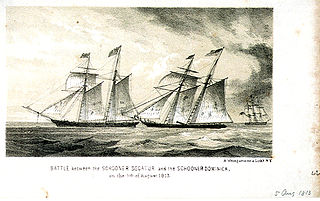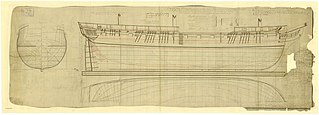Related Research Articles

HMS Majestic was a 74-gun third-rate ship of the line launched on 11 December 1785 at Deptford.

Révolutionnaire, was a 40-gun Seine-class frigate of the French Navy, launched in May 1794. The British captured her in October 1794 and she went on to serve with the Royal Navy until she was broken up in 1822. During this service Revolutionnaire took part in numerous actions, including three for which the Admiralty would in 1847 award clasps to the Naval General Service Medal, and captured several privateers and merchant vessels.

HMS Lark was a 16-gun ship sloop of the Cormorant class, launched in 1794 at Northfleet. She served primarily in the Caribbean, where she took a number of prizes, some after quite intensive action. Lark foundered off San Domingo in August 1809, with the loss of her captain and almost all her crew.

HMS Sappho was a Cruizer class brig-sloop built by Jabez Bailey at Ipswich and launched in 1806. She defeated the Danish brig Admiral Yawl in a single-ship action during the Gunboat War, and then had a notably successful two months of prize-taking in the first year of the War of 1812. She was wrecked in 1825 off the Canadian coast and then broken up in 1830.
HMS Abergavenny was originally Earl of Abergavenny, an East Indiaman sailing for the British East India Company (EIC). As an East Indiaman she made two trips to China between 1790 and 1794. The Royal Navy bought her in 1795, converted her to a 56-gun fourth-rate ship of the line, and renamed her. One year later the East India Company built a new and much larger ship which was also named the Earl of Abergavenny and which sank off Weymouth Bay in 1805. HMS Abergavenny was sold for breaking in 1807.
During the French Revolutionary and Napoleonic Wars the British Royal Navy made use of hired armed vessels, one of which was His Majesty's hired armed cutter Nimrod. Three such vessels are recorded, but the descriptions of these vessels and the dates of their service are such that they may well represent one vessel under successive contracts. The vessel or vessels cruised, blockaded, carried despatches, and performed reconnaissance.
HMS Laura was an Adonis-class schooner of the Royal Navy, launched in 1806 at Bermuda. Laura served during the Napoleonic Wars before a French privateer captured her at the beginning of the War of 1812. She was briefly an American letter of marque before the British recaptured her in 1813. Despite having recaptured her, the British did not return Laura to service.
His Majesty's hired armed cutter Courier appears twice in the records of the British Royal Navy. The size and armament suggests that both contracts could represent the same vessel, but other information indicates that the second Courier had been captured from the French in the West Indies. On the first contract the captain and crew were awarded clasps to the Naval General Service Medal, one for a boat action and one for a single ship action in which they distinguished themselves.

HMS Dominica was the French letter of marque schooner Duc de Wagram, which the British captured in 1809 in the Leeward Islands and took into the Royal Navy in 1810. The American privateer Decatur captured her in 1813 in a notable single-ship action. However, Majestic recaptured her in 1814. She was wrecked in 1815

HMS Cambrian was a Royal Navy 40-gun fifth-rate frigate. She was built and launched at Bursledon in 1797 and served in the English Channel, off North America, and in the Mediterranean. She was briefly flagship of both Admiral Mark Milbanke and Vice-Admiral Sir Andrew Mitchell during her career, and was present at the Battle of Navarino. Cambrian was wrecked off the coast of Grabusa in 1828.
HMS Duguay-Trouin was an 18-gun French privateer sloop launched in 1779 at Le Havre. Surprise captured her in 1780 and the British Royal Navy took her into service under her existing name. It sold Duguay-Trouin on 30 October 1783. She then became the West Indiaman Christopher, and later a slaver. She was lost at Charleston in September 1804.
Numerous French privateers have borne the name Vengeur ("Avenger"):
Princess of Wales was launched at Stockton in 1795. She made three voyages as an "Extra ship", i.e., under charter, for the British East India Company (EIC). On her return she became a West Indiaman. A privateer captured her in 1803 as she was coming back to England from Jamaica, but British privateers immediately recaptured her. She continued sailing to Jamaica though later, under a new owner, she traded more widely. She probably foundered in 1828, and is last listed in 1830.

HMS Barrosa was launched in 1812 for the Royal Navy and served during the War of 1812 during which she captured several prices. After the war she spent a decade or so (1823–1833) on harbour duties. The navy sold Barrosa in 1841.

HMS Narcissus was the lead ship of the Royal Navy Narcissus-class 32-gun fifth-rate frigate, launched in 1801. She participated in the War of 1812.
Resolution was a privateer lugger operating out of Guernsey in 1793. She made several captures, most notably of the French East Indiaman St.Jean de Lone.
Between 1793 and 1805, five cutters served the British Royal Navy as hired armed vessels under the designation HM hired cutter Rose:
HMS Cockchafer was a United States schooner, possibly Spence or Spencer, that the Royal Navy (RN) captured and employed as a ship's tender. She captured two American armed brigs, one in a single-ship action. The Navy sold her in 1815.
Malouin was a schooner commissioned as a privateer in Saint-Malo in June 1803 under Captain Loriot. She was captured in July 1803.
References
- Thomas, Kimberley (2019) Beyond the Plantation: Salt, Turks Islands, Bermuda and the British Atlantic World, 1660s-1850s. PhD Thesis, Yesu Persaud Centre for Caribbean Studies, University of Warwick.